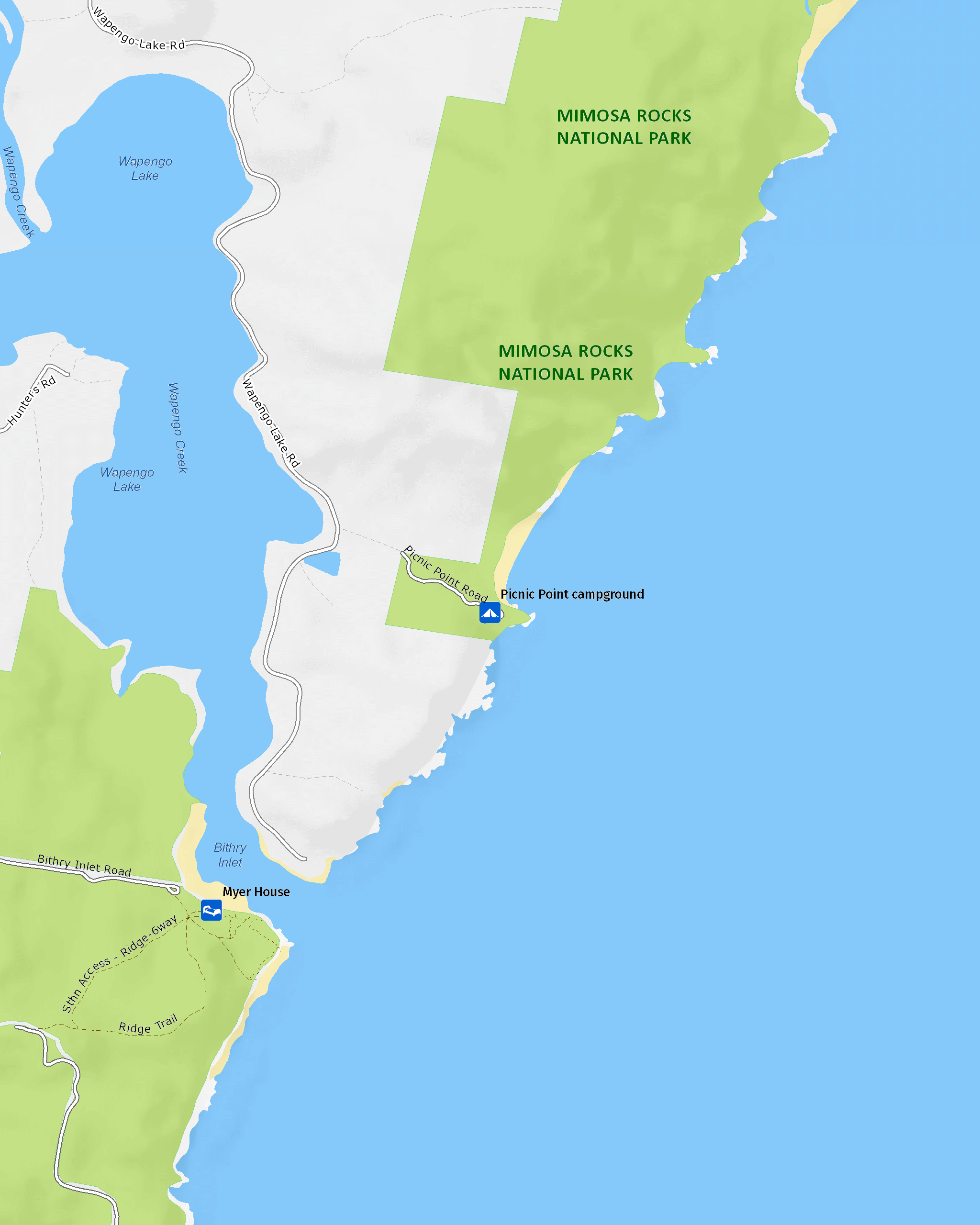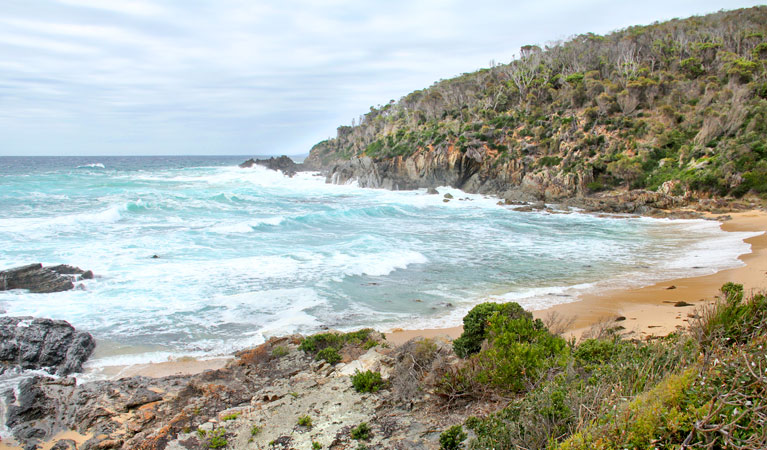Overview
Camp by the beach and banksia trees at Picnic Point campground. Find your favourite fishing spot; enjoy swimming and scenic views of the stunning Sapphire Coastline.
| Number of campsites | 17 |
|---|---|
| Camping type | Tent, Camper trailer site, Camping beside my vehicle |
| Facilities | Toilets, unpowered sites, marked sites, barbecue facilities, picnic tables, carpark |
| What to bring | Cooking water, drinking water, firewood |
| Group bookings | Book up to 40 people or 9 sites online. For larger groups, make a group booking enquiry. |
| Please note |
|
Like the idea of basing yourself just steps away from your next catch? Then head to Picnic Point campground.
Nestled beside two beautiful sandy beaches, the campground is ideally located for beach fishing. Choose your perfect campsite amongst the banksias, then grab your rod and see if you can hook some bream to barbecue back at the campground.
Why not try a pretty coast walk or refresh with a dip in the ocean? And don’t forget to do as the name suggests and enjoy a picnic on the point. At the end of the day, fall asleep to the sound of crashing waves and get ready to do it all again tomorrow.
Map

Map legend

Local alerts
For the latest updates on fires, closures and other alerts in this area, see https://www.nationalparks.nsw.gov.au/camping-and-accommodation/campgrounds/picnic-point-campground/local-alerts
Bookings
- National Parks Contact Centre
- 7am to 7pm daily
- 1300 072 757 (13000 PARKS) for the cost of a local call within Australia excluding mobiles
- parks.info@environment.nsw.gov.au
Park info
- in Mimosa Rocks National Park in the South Coast region
Mimosa Rocks National Park is always open but may have to close at times due to poor weather or fire danger.
Visitor info
All the practical information you need to know about Picnic Point campground.
Getting there and parking
Picnic Point campground is at the end of Wapengo Lake Road, off the Tathra-Bermagui Road. The road leading to Picnic Point is a private road – please leave the gate as you found it.
Road quality
Check the weather before you set out as roads within the park can become boggy when it rains. Access road, picnic areas and campground at this site are not suitable for large vehicles including caravans, motorhomes and buses.
- Unsealed roads
Vehicle access
- 2WD vehicles
Weather restrictions
- All weather
Parking
Parking is available next to your campsite and in hard-packed ground carparks at the campground. There is a limit of 1 vehicle per campsite.
Best times to visit
There are lots of great things waiting for you in Mimosa Rocks National Park. Here are some of the highlights.
Spring
Head to one of the park's headlands for great whale watching – don't forget your binoculars for up close views.
Summer
A great time for a family camping holiday by the beach, try Aragunnu campground or Gillards campground .
Winter
Keep your eyes on the parks winter-flowering plants, like spotted gums, mugga ironbark and coastal banksia for honeaters and lorikeets.
Facilities
- Firewood is not provided and cannot be collected from the park. Please bring your own firewood, or you can purchase firewood in nearby towns.
- Water is not available at this campground.
Toilets
The toilet at the campground is an ambulant toilet.
- Non-flush toilets
Types of sites
- Unpowered sites
- Marked sites
Barbecue facilities
There are wood fireplaces at some (not all) of the campsites.
- Fire rings (bring your own firewood)
Picnic tables
Carpark
Step-free access
The campground is flat and step-free but there are no pathways. You'll need to cross over flat grass and hard-packed ground to reach the facilities.
There are steps along the access points to the beach.
Seats and resting points
There are 4 benches at the campground:
- 2 benches with backrests on the western side
- 2 benches without backrests on the eastern side
Maps and downloads
Accessibility
Disability access level - medium
- Picnic Point campground is mostly flat and step-free, but there are no pathways. You'll need to cross over flat grass and hard-packed ground to reach the facilities.
- The campground has an ambulant toilet and bench seats for resting.
- There's a single accessible picnic table set on a concrete slab.
- The access trails to the beach have up to 25 steps - you may need assistance in this area.
Permitted
Fishing
A current NSW recreational fishing licence is required when fishing in all waters.
Prohibited
Gathering firewood
Firewood cannot be collected in Mimosa Rocks National Park. Penalties apply.
Pets
Pets and domestic animals (other than certified assistance animals) are not permitted. Find out which regional parks allow dog walking and see the pets in parks policy for more information.
Smoking
NSW national parks are no smoking areas.
Learn more
Picnic Point campground is in Mimosa Rocks National Park. Here are just some of the reasons why this park is special:
Ancient connections

Mimosa Rocks National Park lies within the traditional Country of the Yuin people who have inhabited the region for thousands of years, climbing these headlands, swimming in the rivers and lakes, crossing the sand dunes and walking the beaches. The plants and animals within the park were a source of food, medicine and shelter for the Yuin people and the park's landscape is strongly connected to Dreaming stories. Be sure to take the Mimosa Rocks walk for an insight into the Aboriginal heritage within the park.
- Living Country living culture Join us for Living Country, living culture – a Stage 1 HSIE excursion in Mimosa Rocks National Park. An Aboriginal guide will help students understand the importance of culture and caring for Country.
- Living Country, living culture Join us for Living Country, living culture – a Stage 2 HSIE excursion in Mimosa Rocks National Park. In this cross-curricular program, an Aboriginal guide will help students understand the importance of culture and caring for Country.
- Mimosa Rocks walking track Great for walking with children, the easy Mimosa Rocks walk takes you along a short boardwalk to a lookout. You may spot the Mimosa shipwreck on the rocks below.
Bygone eras

White settlers arrived in the Bega Valley in the 1830s, attracted by its grazing and farming potential, with Bega township being established in 1851. In its earliest years the town traders used Moon Bay as a regional port shipping Timber and sheep products from its sheltered waters. You can still see a log-slide and mooring ring from bygone days, or take a walk to 'Riverview' in the park's south-east, the remains of these historic premises have important associations with the 19th century timber and coastal shipping industries.
- Mimosa Rocks walking track Great for walking with children, the easy Mimosa Rocks walk takes you along a short boardwalk to a lookout. You may spot the Mimosa shipwreck on the rocks below.
- Moon Bay A short and easy walking track descends steeply to the secluded beach at Moon Bay in Mimosa Rocks National Park. Enjoy a picnic on the sand and explore the historic heritage of the area.
Plant spectacular

When you’re driving from the south and about to cross the Bega River, you are sure to notice the knife edge boundary of spotted gum, with an understorey of burrawang palms; characteristic vegetation of Mimosa Rocks National Park. When exploring the dunes and cliffs of the park you’ll see coastal banksia, coast wattle and drooping she-oak that can withstand winds and salty air. Check the gullies for the tubular flowers of the endangered chefs hat correa, so called because it’s a similar shape to a chef’s hat.
- Merimbula guided photography tour Capture Merimbula’s stunning scenery on this unique tour guided by Mark Gray Gallery and Photography Tours. It’s a great way to learn new photography skills while exploring this magical area.
- Mimosa Rocks walking track Great for walking with children, the easy Mimosa Rocks walk takes you along a short boardwalk to a lookout. You may spot the Mimosa shipwreck on the rocks below.
- Moon Bay A short and easy walking track descends steeply to the secluded beach at Moon Bay in Mimosa Rocks National Park. Enjoy a picnic on the sand and explore the historic heritage of the area.
Wildlife haven

The park provides refuge for koalas, swamp wallabies and ringtail possums, to name a few. Of an evening at Aragunnu campground, you may not see yellow-bellied gliders flitting between trees, but you might be able to hear their distinctive cackling sound that cuts through the silence of the night. At Gillards campground you may well see a long-nosed potoroo. About the size of a rabbit, they look quite similar to a bandicoot, except that they hop in a similar way to a kangaroo. The potoroo is nocturnal, so you are most likely to see them in the evening. The park is an important stop for many migratory birds that nest along the park’s coastline. Look along the beaches and rock platforms – you may see threatened hooded plovers or pied oystercatchers. The bar-tailed godwit stops by briefly in summer during its migration from Alaska to New Zealand. It’s a well deserved stop off as the bar-tailed godwit makes the longest known non-stop flight of any bird and the longest journey without pausing to feed by any animal. Look for them around the park’s lakes and lagoons.
- Wajurda Point lookout Wajurda Point lookout, in Mimosa Rocks National Park offers coastal and ocean views with seasonal whale watching opportunities.
Plants and animals protected in this park
Animals
-

Sugar glider (Petaurus breviceps)
The sugar glider is a tree-dwelling Australian native marsupial, found in tall eucalypt forests and woodlands along eastern NSW. The nocturnal sugar glider feeds on insects and birds, and satisfies its sweet tooth with nectar and pollens.
Plants
-

Wonga wonga vine (Pandorea pandorana)
The wonga wonga vine is a widespread vigorous climber usually found along eastern Australia. A variation of the plant occurs in the central desert, where it resembles a sprawling shrub. One of the more common Australian native plants, the wonga wonga vine produces bell-shaped white or yellow flowers in the spring, followed by a large oblong-shaped seed pod.
-

Black sheoak (Allocasuarina littoralis)
The black sheoak is one of a number of casuarina species found across the east coast of Australia and nearby tablelands. Growing to a height of 5-15m, these hardy Australian native plants can survive in poor or sandy soils. The barrel-shaped cone of the black sheoak grows to 10-30mm long.
-

Blueberry ash (Elaeocarpus reticulatus)
The blueberry ash is a rainforest shrub which produces blue olive-shaped berries and spectacular bell-shaped flowers, which often appear on the plant together. It is a tall slender shrub or small tree found in rainforest, tall eucalypt forest and coastal bushland in eastern NSW, south-east Queensland and Victoria.
-

Grey mangrove (Avicennia marina)
Grey mangrove is the most common and widespread mangrove found within intertidal zones across Australia, and throughout the world. Growing to a height of 3-10m, they thrive best in estuaries with a mix of fresh and salt water. They excrete excess salt through their long thick leaves, and absorb oxygen through their aerial root system.

